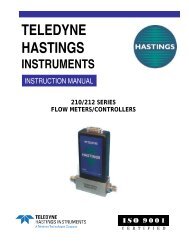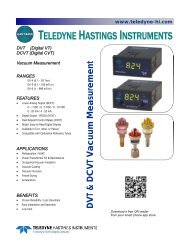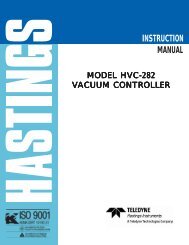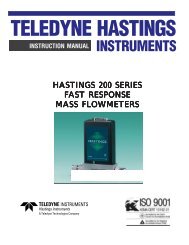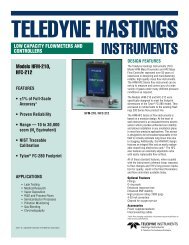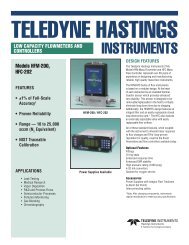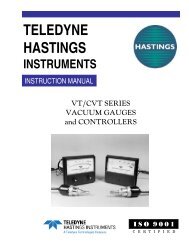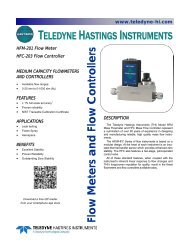HFM-301/305 HFC-303/307 - Teledyne Hastings Instruments
HFM-301/305 HFC-303/307 - Teledyne Hastings Instruments
HFM-301/305 HFC-303/307 - Teledyne Hastings Instruments
- No tags were found...
Create successful ePaper yourself
Turn your PDF publications into a flip-book with our unique Google optimized e-Paper software.
2.8. Range Changing<br />
Changing the range of a flow controller can be done in the field, but calibration is required. It is<br />
recommended however, that the unit be sent back to the factory along with the new range desired, gas<br />
and operating parameters. Consult factory for more information.<br />
2.9. Output Filter<br />
The flow output signal may have noise superimposed on the<br />
mean voltage levels. This noise may be due to high<br />
turbulence in the flow stream that the fast sensor is<br />
measuring or it could be electrical noise when the flow meter<br />
has a high internal gain (i.e. 5 sccm full scale meter).<br />
Varying levels of radio frequency noise or varying airflow over<br />
the electronics cover can also induce noise.<br />
Noise can be most pronounced when measuring the flow<br />
output with a sampling analog/digital (A/D) converter. When<br />
possible, program the system to take multiple samples and<br />
average the readings to determine the flow rate.<br />
Figure 2-8<br />
If less overall system noise is desired, a jumper may be<br />
installed over the pins of JP-1 on the flow measurement card.<br />
See Figure 2-8. Covering the pins closest to the “D” connector<br />
will activate a resistor-capacitor (RC) filter that has a time<br />
constant of one second. This will change the settling time of<br />
the indicated flow rate to approximately 4 seconds. Covering<br />
the other two pins will change the response time to approx. 1<br />
second. This adjustment will not affect the calibration of the<br />
flow meter circuit or the actual flow response to change in<br />
command signal (flow controllers). This will only slow down<br />
the indicated response (output voltage/current).<br />
2.10. Controlling Other Process Variables<br />
Normally, a flow controller is setup to control the mass flow. The control loop will open and close the<br />
valve as necessary to make the output from the flow measurement match the input on the command<br />
line. Occasionally, gas is being added or removed from a system to control some other process variable.<br />
This could be the system pressure, oxygen concentration, vacuum level or any other parameter which is<br />
important to the process. If this process variable has a sensor that can supply an analog output signal<br />
proportional to its value then the flow controller may be able to control this variable directly. This<br />
analog output signal could be 0 - 5 Volts, 0 - 10 Volts (or 4 - 20 mA for units with 4 - 20 mA boards) or<br />
any value in between.<br />
On the CONTROLLER card there is a jumper (JP-1) that sets whether the control loop controls mass flow<br />
or an external process variable. See Figure 2-9. If the jumper connects the top two pins, the loop<br />
controls mass flow. If the jumper connects the bottom two pins, the loop controls an external process<br />
variable. This process variable signal must be supplied on pin 13 of the D-connector (for H pin out units)<br />
or pin 12 of the D-connector (for U pin out units) of the measurement card. When the controller is set<br />
for external variable control it will open or close the valve as necessary to make the external process<br />
variable signal match the command signal. The command signal may be 0 - 5 Volts, 0 - 10 Volts (4 - 20<br />
mA for 4 - 20 mA input/output cards) or any value in between. If the process variable has a response<br />
time that is much faster or slower than the flow meter signal it may be necessary to adjust the gain<br />
potentiometer.<br />
2.11. Command Input<br />
The flow controller will operate normally with any command input signal between 0 - 10 Volts (4 - 20 mA<br />
for units with 4 - 20 mA input/output cards). If the command signal exceeds ±14 volts it may damage the<br />
circuit cards. During normal operation the control loop will open or close the valve to bring the output<br />
Manual: 152-082010 <strong>301</strong>-<strong>305</strong>-306_<strong>303</strong>-<strong>307</strong> Series Page 16 of 35



